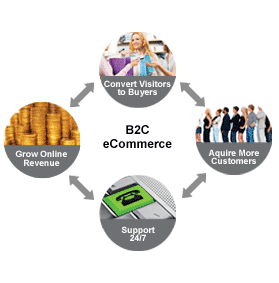With the advent of burgeoning consumerism in India, E-Commerce got a massive fillip after 2010 when it catapulted itself to emerge as the fastest growing sector of India’s growth story. The formidable pace at which hordes of E-commerce websites sprouted is another indicator of the untapped potential that lies in India. But if we zoom in further on the current E-commerce “scene” saturated with numerous players, we would easily figure they inherently cater to just one segment. E-commerce is a much broader term that cannot be shackled by just the B2C segment.

After all, almost all the major websites focus on the end consumer, “common man” or the average person you might bump into the streets of a Tier 2 or 3 city in India. But things have begun to get adrift lately. There is a new sector that is steadily rising in the wings waiting to get on centre-stage and compete with the established honchos of B2C e-commerce. But the turf is different this time round, E-commerce’s focus has shifted to B2B, which is paving the way for new entrants to spoil the booming party. It‘s expected that by 2020 B2B e-commerce in India would touch the Rs.45 Lakh crore threshold positively.
It was already pegged at over Rs.19 Lakh crore in December 2015. B2B websites typically cater to businesses and fulfill the industrial needs of its customers- both large-scale and small-medium enterprises. These customers are completely different from what the B2C customers are. With industrial output in India on the rise alongside widespread urbanization and infrastructural developments on the upswing, the mushrooming of factories needs a definitive supply of industrial tools/machinery, supplies, etc. to keep going strong. That’s where the B2B segment kicks in with a gleeful appetite to satisfy this newly emerging customer base. Many new B2B websites have cropped up like IndustryBuying.com that serve as a simplified platform for industrial buyers and suppliers and hooks them up with products of their use.
There’s another good news, by 2020, B2B in the world is expected to reach $6.7 Trillion, and it will make a bigger leap as compared to the B2C segment. The global B2B e-commerce market is already twice as big as B2C market pegged somewhere around $1.7 trillion. However, challenges are galore for Indian B2B e-commerce players and it lies in the dissimilarity with the currently rampant B2C scene.
The primary difference between them is – in B2C sales are simple since prices are fixed and shipping is easy. Also, very little regulation or tax complexity comes into play, and products are easy to showcase and market. In a totally contrasting B2B setting, prices are highly variable with much higher volumes that necessitates a flexible shipping and logistics solution in a disruptive market where B2B is at a nascent stage in India. While Amazon and Alibaba have become global B2B powerhouses, their imminent venture in India is only going to split wide open the race.
According to a report by Ahmedabad based e-commerce consultant firm Ecumen.in, if 100% FDI capital is allowed in B2B e-commerce market, it would further aggravate innovation like ERP integration (buyer and supplier), single window buying and service/solution alignment as per business needs. Also, there’s silver lining- The much needed and high likely implementation of GST in 2016 would make India a formidable market and that could further help the steadily rising B2B e-commerce flourish.
Author Bio
Mayank is an avid reader, musician, and YouTuber who loves everything about the Internet. In this article the author throws light on some essential points to ponder before you purchase office furniture. You can reach him @ Twitter. https://twitter.com/MayanktheKazama
